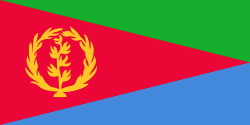Debub Region, also known as the South Region (Tigrinya: ዞባ ደቡብ, Regione del Sud), is an administrative region of Eritrea. The region was formed on 15 April 1996, from the historical provinces of Serae and Akele Guzai. It lies along a portion of the national border with Ethiopia. As of 2005, the region had a population of 952,100 compared to a population of 839,700 in 2001. The net growth rate was 11.81 per cent. The total area of the province was 8000.00 km2 and the density was 119.01 persons per km2. The highest point in Eritrea, is Mount Soira 3018 m, is located in the region, situated east of Senafe. It shares borders with Central Region in the north, Zoba Northern Red Sea in the east, Gash Barka in the west and Ethiopia in the south. It is the largest region in the country by population.
Zoba Debub is one of the six Zobas (Regions) of Eritrea which is located in the southern part of the country with longitude of 38° 15' - 39° 40' East and latitude 14° 25' - 15° 15 North. It shares borders with Zoba Maekel (Central Region) in the north, Zoba Northern Red Sea in the east, Gash Barka in the west and Ethiopia in the south. It is the largest region in the country by population. This region has an area of around 8,000 square kilometers, and its capital is Mendefera (Adi Ugri). Other towns in Debub include Adi Keyh, Mayduma, Adi Quala, Dekemhare, Debarwa, Segeneyti, Areza and Senafe. The archeological sites of Metera, Qohaito and Mendefera are also located here. The highest point in this region, and in Eritrea, is Mount Soira 3018 m, situated east of Senafe. The topography of the region has coastal plains, which are hotter than the regions around the highland plateau. There are two rainy seasons, the heavier one during summer and the lighter one during spring. The climate and geography of the region along with other regions of Eritrea is similar to the one of Ethiopia. The hottest month is May recording temperatures up to 30 °C, while the coldest months are December to February when it reaches freezing temperature. The region received around 508 mm of rainfall and the soil is conducive for agriculture.

















